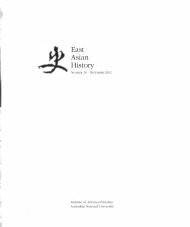(Igor de Rachewiltz) (PDF - East Asian History
(Igor de Rachewiltz) (PDF - East Asian History
(Igor de Rachewiltz) (PDF - East Asian History
- No tags were found...
Create successful ePaper yourself
Turn your PDF publications into a flip-book with our unique Google optimized e-Paper software.
CONFUCIUS IN MONGOLIAN. SOME REMARKSON THE MONGOL EXEGESIS OF THE ANALECTS~ <strong>Igor</strong> <strong>de</strong> <strong>Rachewiltz</strong>It is generally assumed that the Confucian Analects (Lun-yii ~ffiig.g:)were translated into Mongolian and, presumably, published as early as themiddle of the thirteenth century, and that this translation did not survivethe fall of the Yuan.!What we know, in fact, is that the Analects were explained to QubilaiQan c. 1251, when he was still a prince, by Chao Pi MllJl (1220-76), aChinese scholar in his entourage. 2 Given the time and circumstances, wecan safely assume that someone else in Qubilai's retinue translated Chao'slectures for the prince's benefit, i.e., an interpreter (kelemeCi) who ren<strong>de</strong>redChao's exegesis into spoken Mongolian. 3 It is, in<strong>de</strong>ed, very doubtfulthat there existed a written translation of the Analects in Mongolian; atany rate, no Chinese source confirms the existence of such a translation,whereas they give us the titles of several other Chinese works translatedinto that language. 4 While the great sage's obiter dicta as recor<strong>de</strong>d in theClassic of Filial Piety (Hsiao-ching ~~) were subsequently translatedRespectfully <strong>de</strong>dicated to Professor Dr. ShigeoOzawa, doyen of Mongol Studies in Japan.rumen nasulatuyai l1 See S.JagchidandP. Hyer, Mongolia 's Cultureand Society (Boul<strong>de</strong>r: Westview Press, 1979),pp.228, 424, n.l6; Baatar C.H. Hai, "SeveralQuestions in the Mongolian Language Editionsof the Four Classics," paper presented at theInternational Symposium of Mongolian Culture,Taipei, Taiwan, 29-31 May 1992, pp.l and 3,In.l (unpublished).2 See W. Fuchs, "Analecta zur mongolischenUbersetzungsliteratur <strong>de</strong>r Yuan-Zeit," MonumentaSerica11 (1946): 35, 47--8, and nn.45-7.For Chao Pi, see I. <strong>de</strong> <strong>Rachewiltz</strong>, H.- L. Chan,c.-c. Hsiao, P.W. Geier, with the assistanceof M. Wang, eds, In the Service of the Khan.Eminent Personalities of the Early MongolYuan Period (J 200--1300) (Wiesba<strong>de</strong>n:Harrassowitz, 1993), p.763a (In<strong>de</strong>x); M.IRossabi, Khubilai Khan. His Life and Times,(Berkeley, Los Angeles, London: Universityof California Press, 1988), pp.15, 237, n.60.The (as yet unpublished) nien-p'u if.~ ofQubilai prepared by the Australian NationalUniversity Yuan Biographical Project teamconfirms the date 1251 already reported byHai, "Several Questions," p.l; however, Chao'sexegetical activity may well have continuedin the following year or two.3 This was, in<strong>de</strong>ed, the practice at the time.See H. Franke, "Could the Mongol EmperorsRead and Write Chinese?," Asia Major,New Series 3 (1953): 29-30 (reprint in H.Franke, China Un<strong>de</strong>rMongolRule, Al<strong>de</strong>rshot:Variorum, 1994, V). See also the case of theChinese Taoist (Ch'uan-chen ~~) PatriarchCh'ang-ch'un :lHf (Ch'iu Ch'u-chi liJJl1itl,1148-1227) lecturing to Cinggis Qan on theart of longevity in 1222. See A. Waley, trans. ,The Travels of an Alchemist. The Journey ofthe Taoist Ch 'ang-ch 'un from China to theHindukush at the Summons of Chingiz Khan,Recor<strong>de</strong>d by His Disciple Li Chih-ch 'ang(London: Routledge, 1931), p.113. For theterm kelemeCi (mo. kelemurct), see L. Ligeti,"Le tabghatch, un dialecte <strong>de</strong> la languesien-pi ," in L. Ligeti, ed., Mongolian Studies(Amsterdam: Gruner, 1970), pp.292-3.' See Fuchs, "Analecta," p.35ff.57
















